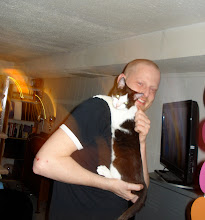For Waste Reduction Week 2013, Call2Recycle®
partnered with Winnipeg Public Library to raise awareness of our battery
recycling program. From October 21-27
all branches of Winnipeg Public Library competed to see which one could collect
the most weight in spent batteries and used cellphones in seven days, earning
the title of Winnipeg’s “Waste Ace”.
To make sure that people in Winnipeg were aware of
Waste Reduction Week and the Call2Recycle program, staff in each of the
branches unleashed their creativity by building eye-catching in-library
displays and signage. From Pembina Trail
to West Kildonan and Westwood to Transcona, giant-sized AA batteries and other
signage appeared hanging from the ceiling, Hallowe’en undead sought batteries
from the living, and some library-goers were even greeted with battery requests
from the characters of Star Wars.
Both Call2Recycle and Winnipeg Public Library
maintained chatter on Facebook and Twitter throughout the week. This, combined with the displays and other
promotional activity, got the message across to Winnipeggers. By the end of the week more than 3,000 kg of
batteries and cellphones had been collected.
That’s the weight of almost eight horses. “The Winnipeg Waste Ace competition is a
testimony to the power of communities,” explains Orysia Boytchuk, Marketing Director,
Call2Recycle. “The library did a great
job in rallying the entire city behind battery recycling, and the entire city
will benefit as a result. It’s amazing
what they managed to accomplish in such a short time.”
At the end of the week it was the community from St.
Vital who triumphed, collecting 471 kg of batteries and used cellphones at
their library branch. Louis Riel Library
came second with 412 kg and River Heights Library third with 309 kg. As the winning branch, St. Vital Library got
to choose the prize Call2Recycle would deliver.
After considering the needs of the local community, the team there
elected to have Call2Recycle purchase a new bike rack for the library. St. Vital Councillor Brian
Mayes responded, "I would like to congratulate those who contributed to
the Call2Recyle initiative by bringing in enough battery material to the St.
Vital Library to garner a new bike rack that will be used by the many patrons
who visit our branch."
Rick Walker, Manager of Library Services, Winnipeg Public Library added, “The St. Vital Library has been well used by the residents of the community for over 50 years. It’s been one of our busier branches since opening in 1963, loaning over 220,000 items annually. It is not surprising that this environmentally-conscious community would finish first in this competition, and it will be great to have a new bike rack that encourages visitors to ride their bike to the library rather than drive.” The new bike rack will be delivered to St. Vital Library in time for spring 2014 bike riding and will serve the community for years to come.
Although Waste Reduction Week has now ended for 2013, Winnipeg Public Library continues to collect for the Call2Recycle program year-round at all 20 branches. Call2Recycle accepts household batteries (weighing up to 5 kg) and used cellphones (any make, model, or age). To find the drop-off location nearest you, visit our online locator or call 888.224.9764.
Rick Walker, Manager of Library Services, Winnipeg Public Library added, “The St. Vital Library has been well used by the residents of the community for over 50 years. It’s been one of our busier branches since opening in 1963, loaning over 220,000 items annually. It is not surprising that this environmentally-conscious community would finish first in this competition, and it will be great to have a new bike rack that encourages visitors to ride their bike to the library rather than drive.” The new bike rack will be delivered to St. Vital Library in time for spring 2014 bike riding and will serve the community for years to come.
Although Waste Reduction Week has now ended for 2013, Winnipeg Public Library continues to collect for the Call2Recycle program year-round at all 20 branches. Call2Recycle accepts household batteries (weighing up to 5 kg) and used cellphones (any make, model, or age). To find the drop-off location nearest you, visit our online locator or call 888.224.9764.



